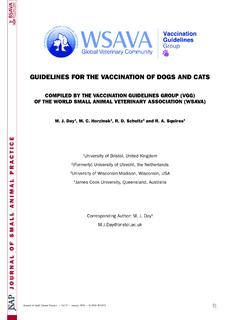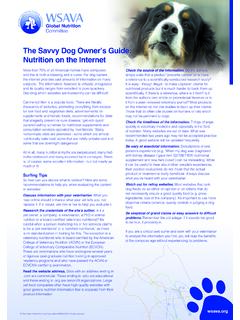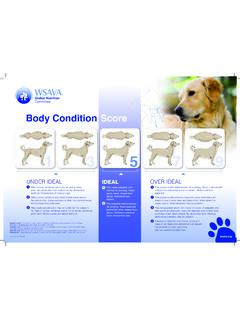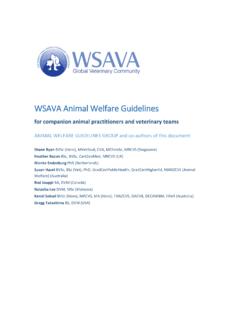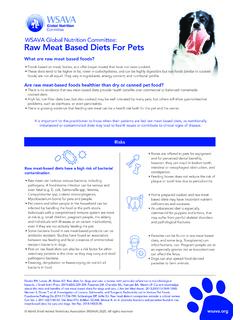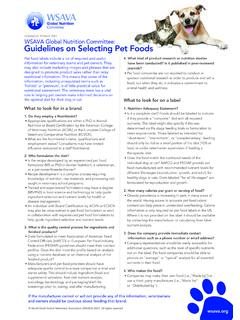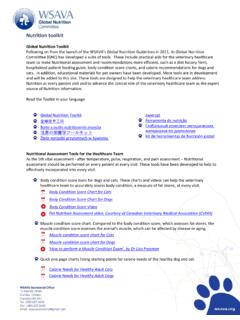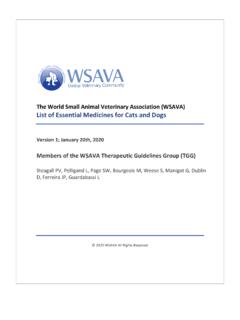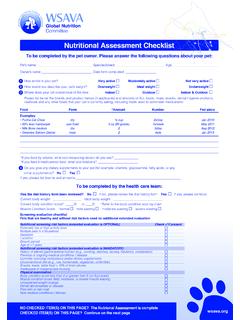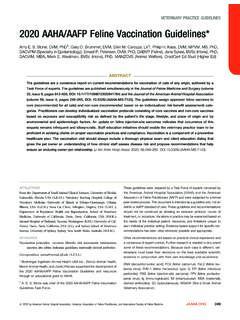Transcription of GUIDELINES FOR RECOGNITION, ASSESSMENT AND …
1 GUIDELINES FOR RECOGNITION, ASSESSMENT AND TREATMENT OF PAIN WSAVA Global Pain Council members and co-authors of this document: Karol Mathews DVM DVSc DACVECC (Canada) Peter W Kronen Dr Vet Med, DVM DECVAA (Switzerland) Duncan Lascelles BSc BVSc PhD DSAS DECVS DACVS MRCVS (USA) Andrea Nolan MVB DVA PhD DECVAA DECVPT MRCVS (UK) Sheilah Robertson BVMS (Hons) PhD DACVAA DECVAA DECAWBM (WSEL) DACAW MRCVS (USA) Paulo VM Steagall MV MS PhD DACVAA (Brazil/Canada) Bonnie Wright DVM DACVAA (USA) Kazuto Yamashita DVM MS PhD DJCVS (Japan) Journal of Small Animal Practice 2014 WSAVA 1 CONTENTS Introduction SECTION 1: INTRODUCTION TO PAIN, ITS RECOGNITION AND ASSESSMENT 1.
2 Understanding pain ..5 2. Physiology and pathophysiology of pain ..6 3. Recognition and ASSESSMENT of acute pain in cats ..7 4. Recognition and ASSESSMENT of acute pain in 5. Recognition and ASSESSMENT of chronic pain in cats ..11 6. Recognition and ASSESSMENT of chronic pain in dogs ..11 7. Assessing response to treatment of pain in cats and dogs ..13 8. Neuropathic pain ..13 9. Perceived level of pain associated with various conditions ..14 10. Common pain SECTION 2: PAIN MANAGEMENT 11. General approaches to the treatment of 12. 13. Non-steroidal anti-inflammatory drugs (NSAIDs).
3 18 14. Alpha2 adrenoceptor agonists ..20 15. Local anaesthetics ..21 16. Analgesic delivery techniques and tools ..23 17. Adjunctive drugs ..23 18. Non-analgesic drugs: management of the painful patient ..25 19. Physical rehabilitiation ..25 20. Diet and supplements ..26 21. Nursing and supportive care ..27 2 Journal of Small Animal Practice 2014 WSAVA 22. 23. Medical massage ..29 24. Salvage surgical SECTION 3: PAIN MANAGEMENT PROTOCOLS 25. Castration and ovariohysterectomy/ovariectomy in 26. Castration and ovariohysterectomy/ovariectomy in dogs.
4 31 27. Orthopaedic surgery ..32 28. Soft tissue surgery ..33 29. Loco-regional techniques ..35 30. Ophthalmic procedures ..41 31. Dental procedures ..42 32. Emergency and critical 33. Medical pain ..46 34. Pregnant or lactating 35. Neonatal or paediatric patients ..49 36. Neuropathic pain ..50 37. Degenerative joint disease ..52 38. Cancer-related pain ..52 39. WSAVA humane euthanasia overview ..54 Acknowledgements ..54 Recognition of sponsors ..55 References and further reading ..55 Journal of Small Animal Practice 2014 WSAVA 3 INTRODUCTION The ability to experience pain is universally shared by all mammals, including companion animals, and as members of the veterinary healthcare team it is our moral and ethical duty to mitigate this suffering to the best of our ability.
5 This begins by evaluating for pain at every patient contact. However, and despite advances in the recognition and treatment of pain, there remains a gap between its occurrence and its successful management; the inability to accurately diagnose pain and limitations in, and/or comfort with, the analgesic modalities available remain root causes. Both would benefit from the development, broad dissemination, and adoption of pain ASSESSMENT and management GUIDELINES . The World Small Animal veterinary Association (WSAVA) is an association of associations with 91 current members representing over 145,000 small animal veterinarians globally.
6 As such, it is the global voice of the small animal veterinary healthcare team and has a long-standing and successful history of developing global GUIDELINES on the recognition, diagnosis, and/or treatment of common small animal ailments having a global relevance. To date, these have included hepatic, gastrointestinal, and renal diseases; vaccine GUIDELINES ; and nutritional recommendations. Standardization efforts are one of the WSAVA s core activities, which also include animal welfare, continuing education, and the World Congress; the pain ASSESSMENT and management GUIDELINES have unique relevance to all.
7 Based on this background, the Global Pain Council (GPC) was established and charged with the task of developing pain assess- ment and treatment GUIDELINES having universal relevance, taking into account regional differences in attitude, education and available analgesic modalities. These GUIDELINES will be used to enshrine pain ASSESSMENT as the 4th vital sign and be the founda- tion for further continuing education efforts based on regional variations to ensure both clinical relevance and the impetus for advancement. GPC Vision: An empowered, motivated, and globally unified veterinary profession that effectively recognizes and minimizes pain prevalence and impact.
8 GPC Mission: To raise global awareness and provide a call to action based upon an understanding that all animals are sentient and can therefore feel pain and suffer from it. Through the identification of regionally specific resources for recognizing and treating pain, and targeted education, the Global Pain Council strives to elevate the level of confidence and competence in applying pain treatments. Use of this document This document is designed to provide the user with easy-to-implement, core fundamentals on the successful recognition and treatment of pain in the day-to-day small animal clinical practice setting.
9 While not intended to be an exhaustive treatise on the subject matter, the text does provide an extensive reference list and there is additional material on the WSAVA website (www. ) designed to provide resources for those wanting to further their knowledge of this subject matter based on the cur- rent literature. There are no geographic limitations to the occurrence of pain, nor to the ability to diagnose it. The only limiting factors are aware- ness, education, and a commitment to include pain ASSESSMENT in every physical examination. As such, the pain ASSESSMENT GUIDELINES herein should be easily implemented regardless of practice setting and/or location.
10 In contrast, there are real regional differences in the availability of the various classes of analgesics, specific analgesic products, and the regulatory environment that governs their use. This represents a significant hurdle to the ideal management of pain in various regions of the world, irrespective of the ability to diagnose. In the treatment section of these GUIDELINES , these issues are taken into account by the provision of tiered management GUIDELINES beginning with comprehensive pain management modalities that repre- sent the current state of the art followed by alternative protocols that may be considered where regulatory restrictions on analgesic products prevent ideal case management.
